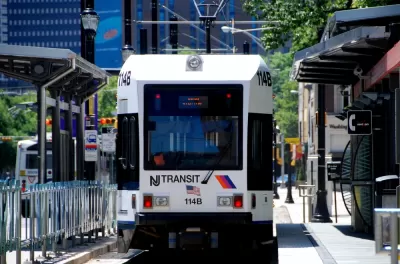The New York Times looks into the decline of New Jersey Transit commuter railroad, rated as outstanding only nine years ago. Much of the decline can be traced to decisions by the Christie administration beginning in 2010.

"Today, New Jersey Transit is in crisis," report Emma G. Fitzsimmons and Patrick McGeehan in this feature New York Times article on the nation's second busiest commuter railroad.
Its aging tracks and trains need billions of dollars in improvements. Delays and fares are rising along with ridership, with passenger cars packed to the breaking point. The century-old tunnel that carries its trains to New York is crumbling. And the agency has gone nearly a year without a permanent leader.
The reporters begin their narrative in the 1990s when NJ Transit "won a coveted award for outstanding public transportation three times."
In the years ahead, faster routes to Manhattan and double-decker trains would put it at the forefront of the nation’s commuter railroads. Even as recently as 2007, it won a leadership award from New York University.
Gov. Chris Christie (R) took office in January 2010. In October of that year, he scrapped the "largest public works project in America," the replacement of the century-old tunnels under the Hudson River, know as Access to the Region's Core, or ARC. But the neglect transcended the tunnel project.
Under his administration, "the state subsidy for the agency has plunged by more than 90 percent," report Fitzsimmons and McGeehan. "Gaping holes in the agency’s past two budgets were filled by fare increases and service reductions or other cuts."
On Sept. 29, a New Jersey Transit train unexplainably accelerated as it entered into the Hoboken Terminal, crashing into the wall and ceiling, and killing a woman waiting on the platform and injuring 108 passengers and staff. Complicating the investigation of the National Transportation Safety Board, one of the train's two black boxes wasn't functioning, an example of the transit system's failure to maintain its equipment.
Even before the crash, "the Federal Railroad Administration began investigating safety problems" of the troubled rail agency, reported Fitzsimmons on Oct. 1.
NJ Transit is certainly not the only neglected rail system in America. D.C. Metro's plight has been detailed extensively in Planetizen. And closer to New Jersey, the New York Metropolitan Transportation Authority's Metro-North Railroad has suffered two of its worst crashes recently: six fatalities in Valhalla, N.Y. in February 2015 and four deaths in the Bronx in December 2013.
Fortunately, Fitzsimmons and McGeehan compare NJ Transit to the two other railroads serving Manhattan.
Today, its trains break down about every 85,000 miles, a sharp decline from 120,000 miles between breakdowns four years ago. The region’s two other large commuter rail systems, the Long Island Rail Road and the Metro-North Railroad, are twice as reliable: Their trains travel more than 200,000 miles between breakdowns. New Jersey Transit also reported more major mechanical failures: 213 in 2014, compared with 89 for the Long Island Rail Road and 169 for Metro-North.
Another stark comparison between the NJ Transit and the MTA railroads is shown by how they prepared for the 2012 Hurricane Sandy and climate change in a report by Andrea Bernstein and Kate Hinds, transit reporters for WNYC. "A third of the [NJ Transit] fleet – 70 locomotives and 273 rail cars – were damaged by flooding from the storm," according to the New York Post.
Recent steep budget-cutting no doubt has contributed to the railroad's woes.
Under the Christie administration, the agency’s finances have been dealt a blow. The direct state subsidy to its operating budget plummeted to $33 million last year from $348 million in 2009, according to the agency’s financial reports.
With the legislature's passage of the first gas tax increase since 1988, transit should receive an influx of funding for capital projects. Gov. Christie signed the 23-cent gas tax increase on Friday. It takes effect on Nov. 1.
A summary of The New York Times article also appears on the October 14, 2016 NARP 'Hotline', third article down.
Hat tip to Kenyon Karl.
FULL STORY: New Jersey Transit, a Cautionary Tale of Neglect

Planetizen Federal Action Tracker
A weekly monitor of how Trump’s orders and actions are impacting planners and planning in America.

Maui's Vacation Rental Debate Turns Ugly
Verbal attacks, misinformation campaigns and fistfights plague a high-stakes debate to convert thousands of vacation rentals into long-term housing.

Cuomo Is the Candidate of Both NIMBYs and Developers. What Gives?
In the New York City mayoral race, odd bedfellows align to preserve the housing status quo.

San Antonio and Austin are Fusing Into one Massive Megaregion
The region spanning the two central Texas cities is growing fast, posing challenges for local infrastructure and water supplies.

Charlottesville Temporarily Has No Zoning Code
A judge ordered the Virginia city to throw out its newly revised zoning code, leaving permitting for new development in legal limbo.

In California Battle of Housing vs. Environment, Housing Just Won
A new state law significantly limits the power of CEQA, an environmental review law that served as a powerful tool for blocking new development.
Urban Design for Planners 1: Software Tools
This six-course series explores essential urban design concepts using open source software and equips planners with the tools they need to participate fully in the urban design process.
Planning for Universal Design
Learn the tools for implementing Universal Design in planning regulations.
Heyer Gruel & Associates PA
JM Goldson LLC
Custer County Colorado
City of Camden Redevelopment Agency
City of Astoria
Transportation Research & Education Center (TREC) at Portland State University
Jefferson Parish Government
Camden Redevelopment Agency
City of Claremont


























